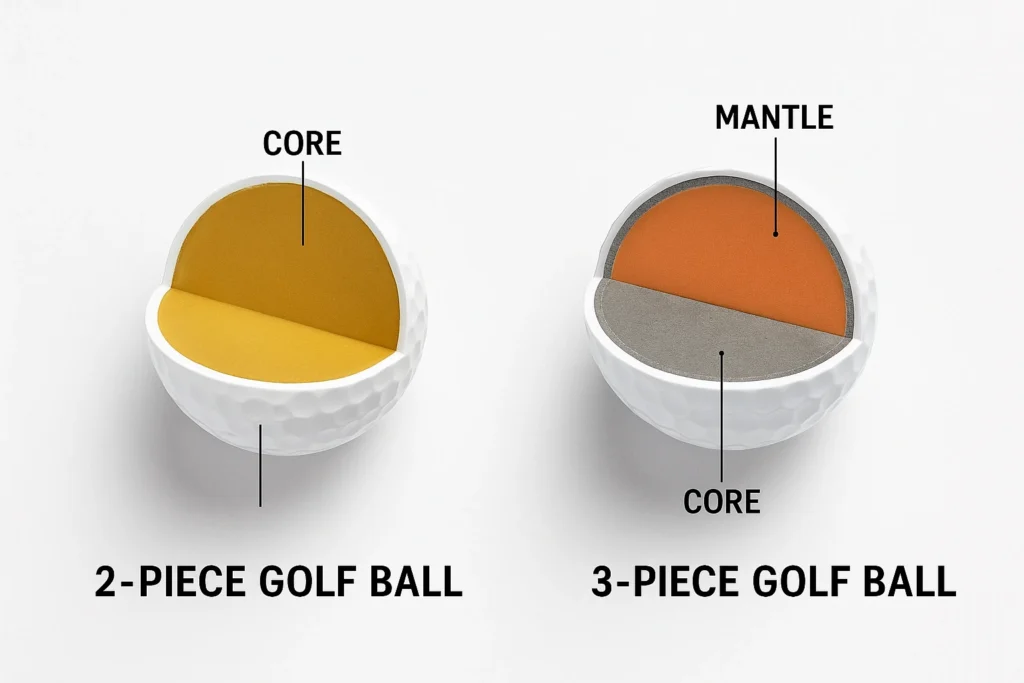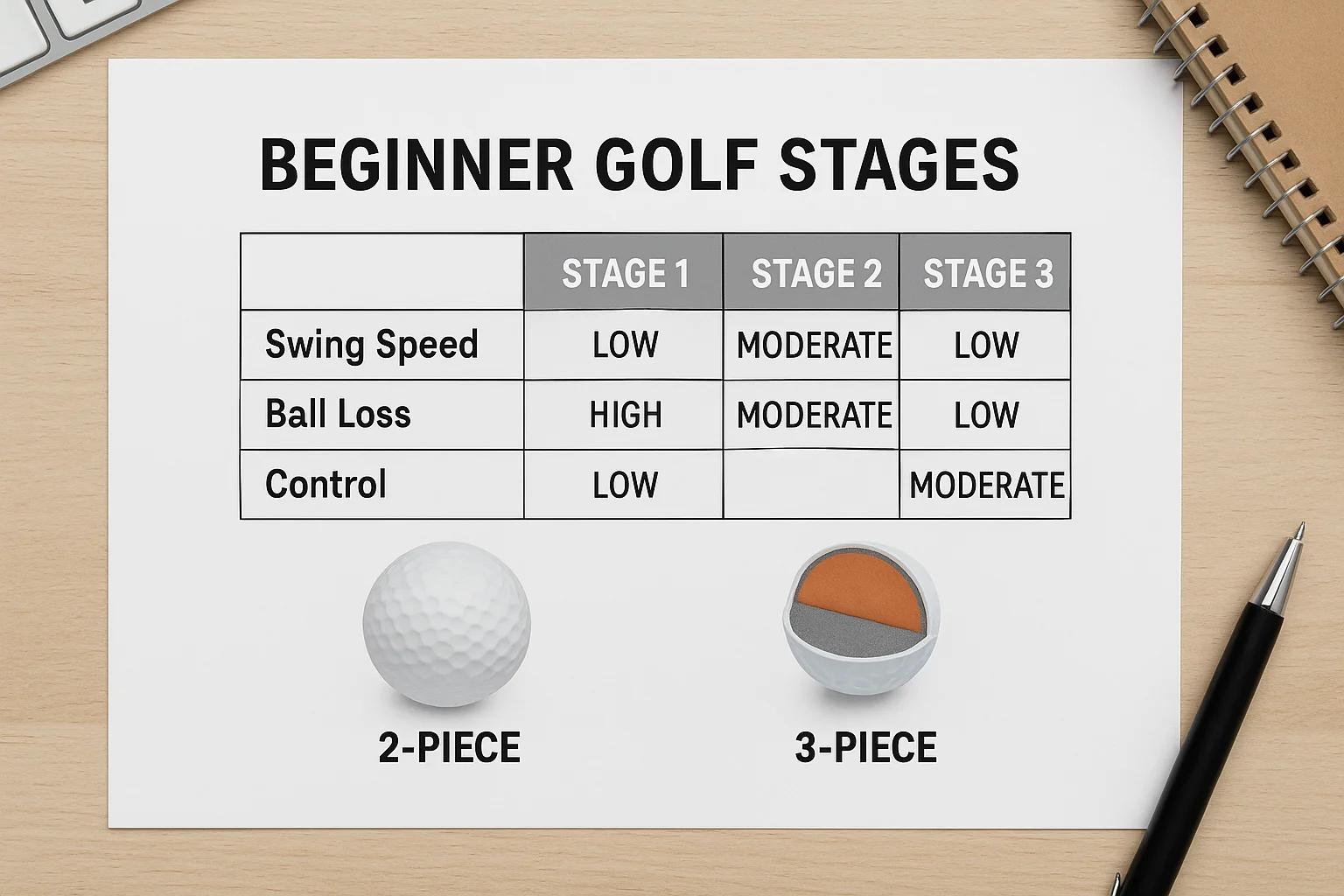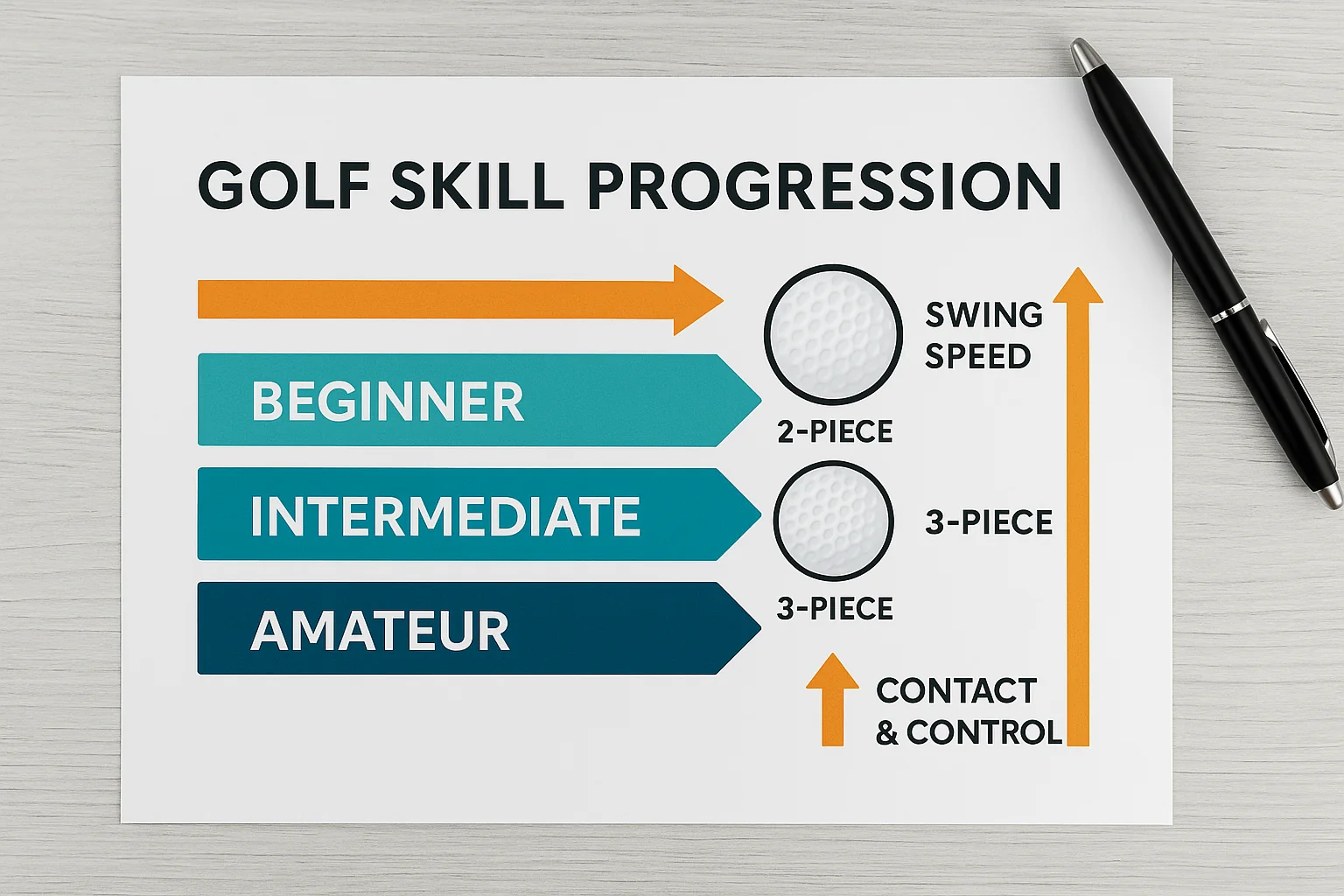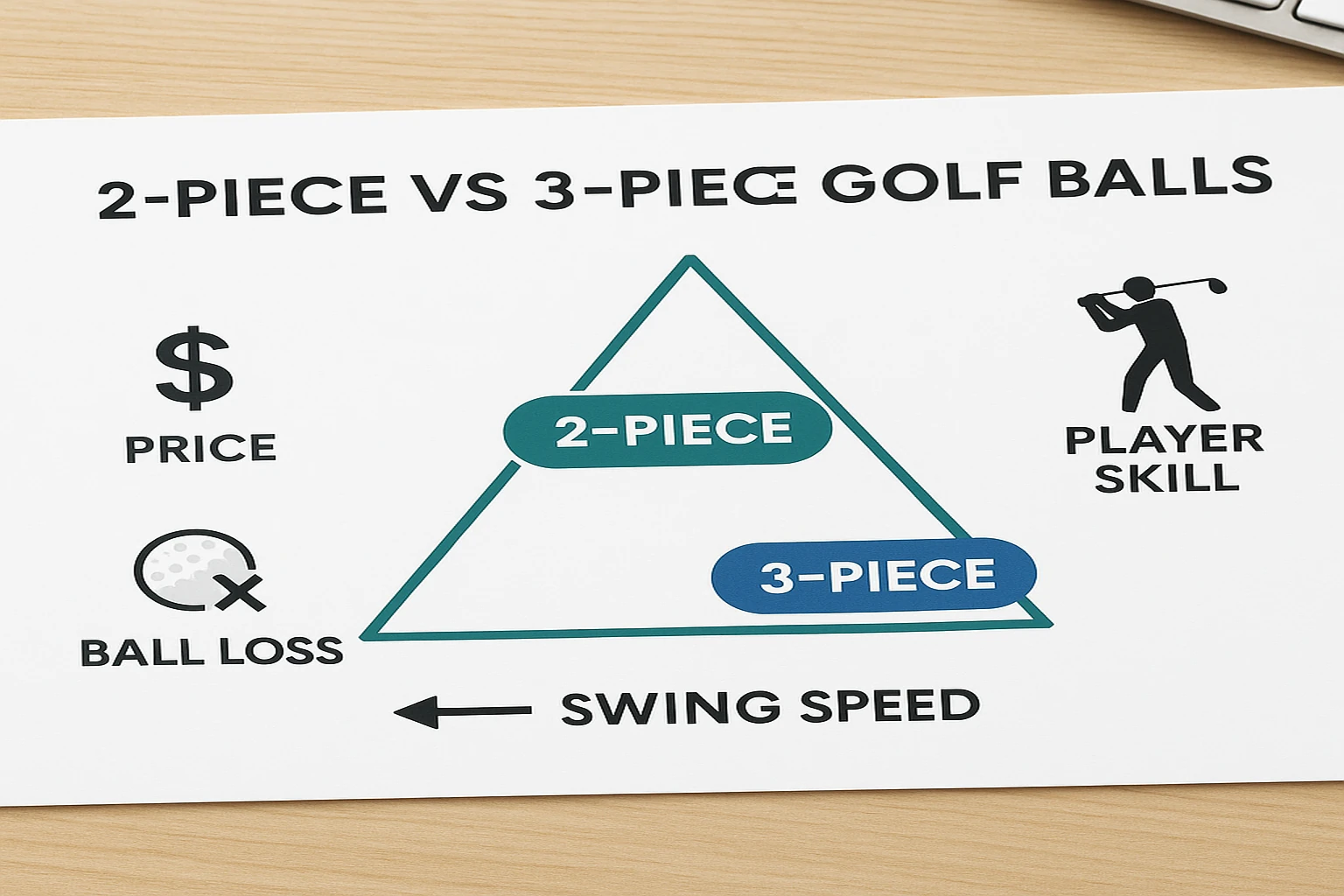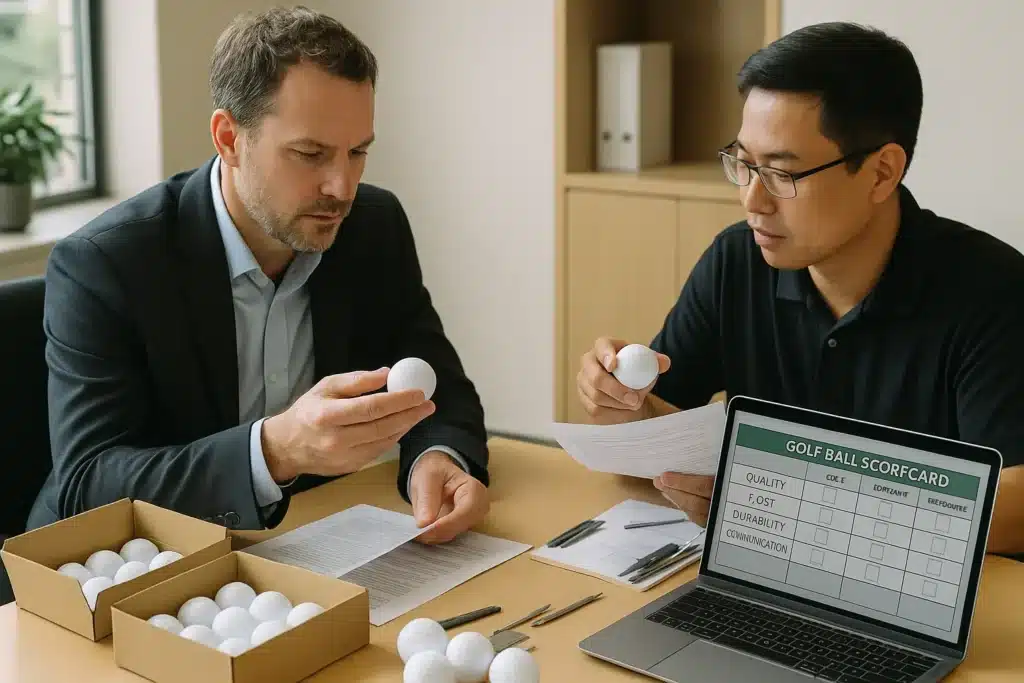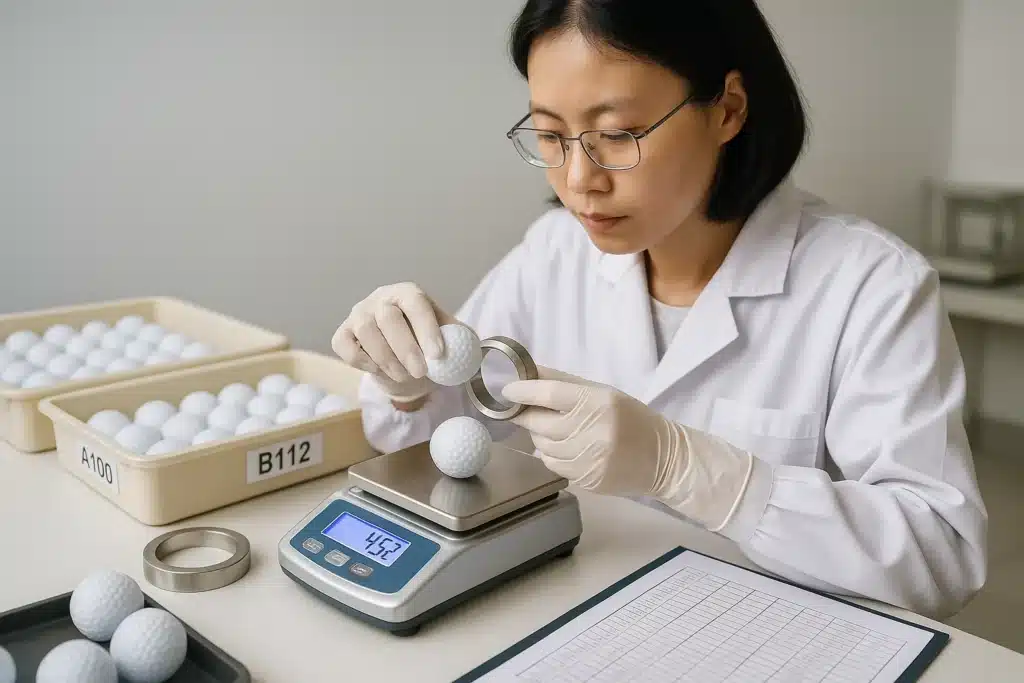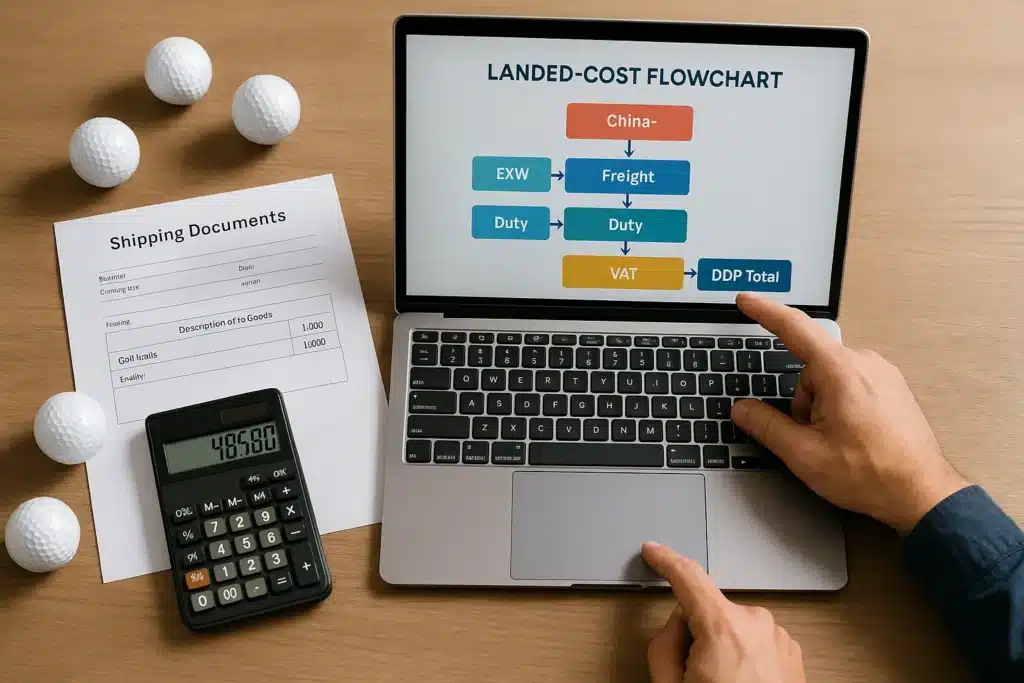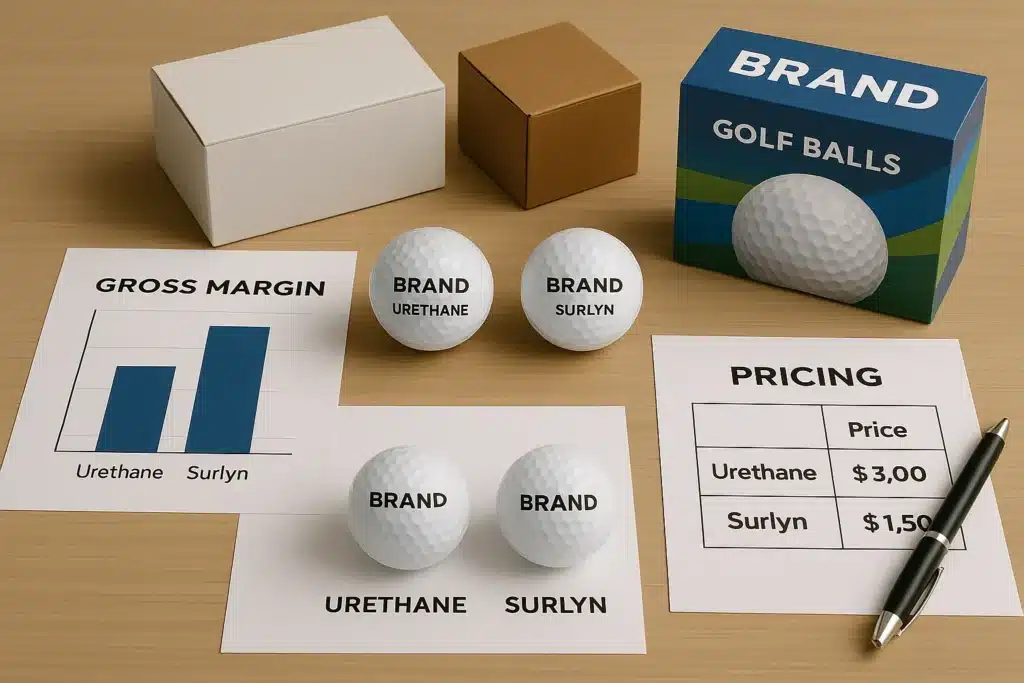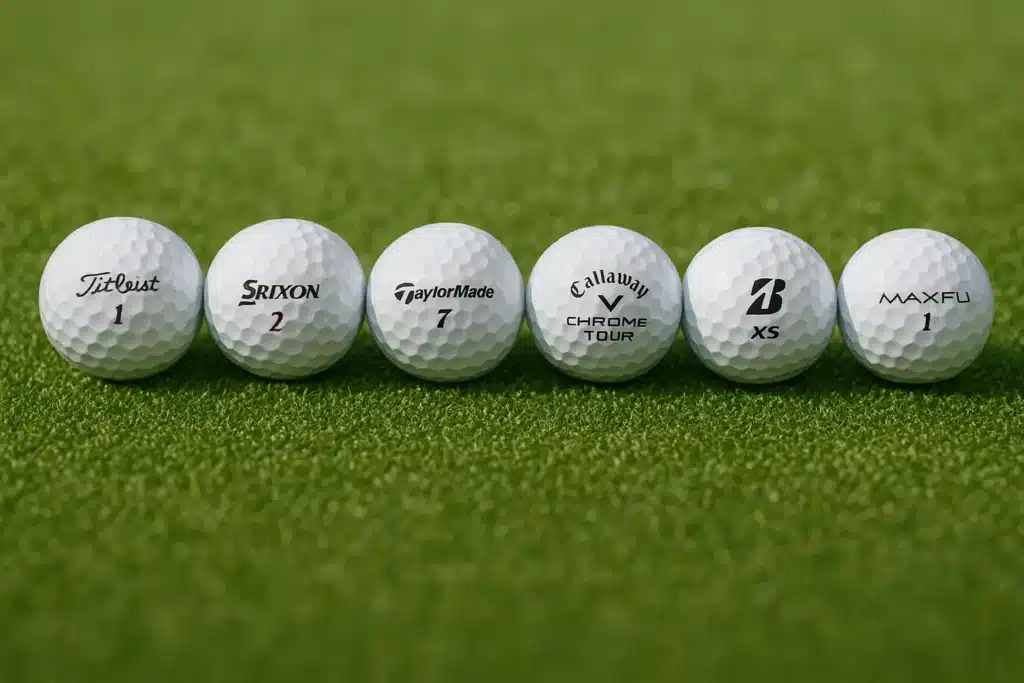If you’re new to golf, choosing between 2-piece and 3-piece golf balls can feel confusing. The good news: you don’t need a tour ball to improve. Match the ball to your stage. For most true beginners, forgiving, low-spin Surlyn options build confidence and save money. As you progress, a 3-piece design adds spin and feel for short-game control.
What’s the real difference between 2-piece and 3-piece golf balls?
A 2-piece ball uses a large core and a Surlyn (ionomer) cover for low spin, durability, and straight flight; a 3-piece ball adds a mantle layer that modestly raises spin and softens feel, helping iron control and green-side shots without sacrificing too much distance. That’s the structural truth behind performance. You’re trading absolute forgiveness for a bit more control. For new players, that trade only pays off after you’re striking the center more often.
Materials & Structure Comparison
A 2-piece ball = big rubber core + Surlyn cover. The cover is tough and slick, resisting scuffs and keeping launch spin low. A 3-piece ball = core + mantle + cover. The mantle tunes spin and feel. With Surlyn covers, 3-piece designs remain durable. With urethane covers, feel softens and wedges grab more, raising short-game spin and stopping power.
How spin, distance & feel vary by layer count
More layers don’t guarantee more distance. Driver distance depends on your swing speed, launch, and ball spin. The mantle helps iron and wedge spin more than it boosts driver yards. Feel changes too. Surlyn feels firmer and lively off the face. Urethane feels softer and “grabbier,” especially with wedges. Early on, a firmer feel can actually help you notice strike quality without overreacting to mis-hits.
Durability & cost differences explained
Surlyn is a workhorse. It shrugs off cart paths and range-style abuse, so 2-piece and 3-piece Surlyn balls are the lowest cost per round. Urethane covers mark more easily and cost more to make, which raises price. If you lose multiple balls each round, durability and price dominate value—control benefits won’t matter if you’re re-teeing.
Here’s how each layer influences ball performance:
| Layer / Component | Spin (Driver → Wedge) | Feel | Durability | Price Impact |
|---|---|---|---|---|
| Core | Sets compression & speed | Firm baseline | High | Low |
| Mantle | Adds mid-iron/wedge spin | Smoother | High | Medium |
| Cover: Surlyn | Lower green-side spin | Firmer | Very high | Low |
| Cover: Urethane | Higher green-side spin | Softer | Moderate | Higher |
✔ True — 3-piece adds control potential, not guaranteed yardage
The mantle mainly helps iron/wedge spin and feel. Distance still depends on your launch and strike quality.
✘ False — “3-piece is always better than 2-piece”
For beginners, low-spin forgiveness and durability from a 2-piece Surlyn often deliver faster early progress.
Which type suits beginner golfers best?
For true beginners (0–3 months), a 2-piece Surlyn ball is best—low spin for straighter flight, high durability to survive mishits, and lower cost so lost balls don’t sting. This combo frees your mind to learn setup, aim, and contact. You’ll shoot better scores by keeping the ball in play than by chasing tour-level spin.
Beginner needs: swing speed, mis-hits, ball loss
Early swings are inconsistent. Club speed is often below 85 mph, contact is scattered, and side-spin makes slices and hooks worse. A lower-spin, straighter-flying 2-piece reduces curve and keeps more shots playable. That stability accelerates learning. You’ll spend more time hitting approach shots and putts, not re-teeing.
Why 2-piece Surlyn balls work better for starters
Two things speed up improvement at this stage: forgiveness and reps. A 2-piece Surlyn ball checks both boxes. It forgives side-spin, rolls out consistently on the green, and handles rough lies without scuffing. Lower unit cost also means you’ll practice more and worry less. Saving money now lets you invest in lessons and short-game time.
Stage-to-ball table (beginner focus):
| Stage | Skill Focus | Best Ball Type | Why |
|---|---|---|---|
| 0–1 month | Get airborne, keep in play | 2-piece Surlyn | Low spin = straighter flight, tough cover resists damage |
| 1–3 months | Approach control basics | 3-piece Surlyn | Mantle adds controllable iron/wedge spin without big cost |
| 3–6 months | Green-side stopping | 3-piece Urethane (if budget OK) | Higher wedge spin for chips, pitches, and partials |
✔ True — Soft feel doesn’t equal beginner-friendly
Soft urethane can feel great but often adds green-side spin you can’t yet control and costs more to lose.
✘ False — “Start soft to learn touch”
Early on, straighter flight and durability matter more than feel nuance.
When should amateur players upgrade to 3-piece balls?
Upgrade when center contact becomes routine and you’re practicing short-game spin—typically around 3–6 months. 3-piece balls add mantle-driven spin and smoother feel, giving you more control on wedges and mid-irons without a big durability penalty if you stay with Surlyn. If you want maximum green-side bite, urethane becomes attractive.
Swing speed & control milestones
You’re likely ready if: (1) swing speed reaches ~85–90 mph with driver, (2) you strike the center most of the time, and (3) you can flight a chip/pitch on purpose. These milestones mean added spin will help you, not punish you, because face-to-path control reduces wild side-spin.
Signs you’re ready for 3-piece (especially PU)
Look for these indicators: your wedge shots hop and run instead of hop and stop; you can hold a 7–8 iron on medium greens but want a bit more check; you track proximity and see 10–15 feet roll-outs you’d like to cut. If budget allows and loss rates fall, 3-piece urethane amplifies that green-side control.
✔ True — Urethane unlocks value when you can control face/path
With solid strike and path control, added friction translates to check-and-stop rather than side-spin curve.
✘ False — “Pro balls help you learn faster” — without control, extra spin = extra curve
Master start lines and contact first; then let urethane’s bite refine proximity.
Are 3-piece balls worth the extra cost for new players?
Yes—but only if you’re losing fewer balls, intentionally practicing short game, and you care about spin/feel. Otherwise, stick to durable 2-piece or 3-piece Surlyn to maximize value. Think in terms of cost per useful stroke, not sticker price. If you still lose three or more balls a round, forgiveness outperforms finesse.
Cost breakdown & usage lifespan
Surlyn models commonly deliver multiple rounds of service with light scuffing. Urethane may mark sooner but still plays well. The big lever is loss rate. If you average two lost balls per round, a premium urethane can double your spend with little scoring upside. Reduce loss first; then buy spin.
Value table by type:
| Ball Type | Avg Price | Durability | Best For |
|---|---|---|---|
| 2-piece Surlyn | Low | Very high | New players; budget focus; high loss |
| 3-piece Surlyn | Low–Mid | High | Transition stage; early control seekers |
| 3-piece Urethane | Mid–High | Moderate | 3–6 month improvers; short-game practice fans |
Who benefits most from urethane covers?
Players who land shots near the target and want predictable check near the hole. If your pitching distance control is emerging and bunker play includes opening the face and using bounce, urethane’s green-side spin turns near-miss pars into tap-ins. That’s when spend translates to score.
My insight: Buy the ball your next 90 days will reward. If your plan is head-down short-game grind, urethane can pay back. If it’s mostly weekend driver fun, Surlyn wins on value.
What’s the best ball structure for each stage of beginner growth?
0–1 month: 2-piece Surlyn for straight flight and toughness. 1–3 months: 3-piece Surlyn to blend distance with controllable spin. 3–6 months: 3-piece urethane if your budget and skills support more green-side control; otherwise, stick with 3-piece Surlyn. This path avoids overpaying early and unlocks feel when it matters.
Beginner segmentation: 0–1, 1–3, 3–6 months
Tie the choice to your current miss. If you fight big curves and chunk/thin chips, durability and low spin trump everything. When curves shrink and approaches start hitting greens, a mantle layer helps hold line and control rollout. Urethane becomes a finishing tool for short-game precision.
Matching needs to spin, feel & control
Pick the lowest-spin, most durable option that still supports your goals. For many, that’s 2-piece Surlyn first, then 3-piece Surlyn, then 3-piece urethane. If you’re budget-sensitive or still losing balls, it’s perfectly smart to stay Surlyn longer and upgrade later.
Stage matrix (restate for clarity):
| Stage | Skill Focus | Best Ball Type | Why |
|---|---|---|---|
| 0–1 month | Get airborne; reduce curve | 2-piece Surlyn | Straighter, tougher, cheapest to lose |
| 1–3 months | Approach spin basics | 3-piece Surlyn | Mantle adds spin feel with good durability |
| 3–6 months | Green-side check & stop | 3-piece Urethane (or Surlyn if budget) | Urethane boosts wedge spin; Surlyn preserves value |
✔ True — Price ≠ faster progress
Progress correlates more with strike consistency, practice time, and tee-to-green decisions.
✘ False — “More expensive balls make you a better golfer”
Use the ball that supports your current miss pattern and practice plan.
FAQ
Do I need a 3-piece golf ball as a high-handicap player?
Usually no. Add a 3-piece only when you’re striking the center consistently and working on short-game spin. Until then, a 2-piece Surlyn keeps flight straighter, lasts longer, and minimizes cost per round. Your handicap drops faster when you avoid penalties and three-putt setups.
High handicaps reflect inconsistency more than lack of spin. A 2-piece keeps you in play, which means more approach and putting reps. That improves scoring skills fastest. When your dispersion narrows and you start landing shots near flags, you’ll gain more by adding mantle-driven spin.
What is the most forgiving golf ball for beginners?
A low-spin, 2-piece Surlyn ball is typically the most forgiving for true beginners. It reduces side-spin, flies straighter, and survives mis-hits, rough lies, and the occasional cart-path kiss. Less curve equals fewer penalties and more playable next shots.
Forgiveness is a system: ball choice, tee height, and target selection. But the ball matters. Surlyn’s toughness and low-spin nature blunt the damage from heel or toe strikes, especially at lower swing speeds. That stability builds confidence from the first tee to the last putt.
Can a 3-piece urethane ball help me spin more around the green?
Yes—urethane covers increase green-side spin and feel, so chips and pitches can check sooner and stop closer. The payoff arrives when your strike and face control are stable. If you’re still blading or chunking, the benefit fades and you just pay more per lost ball.
Once you can land a chip inside a hula-hoop and want to reduce rollout, urethane’s friction helps. It’s also valuable on partial wedges where a crisp strike produces one hop and a quick stop. If your loss rate is low and you practice short game weekly, the upgrade makes sense.
Why do 2-piece balls feel harder than 3-piece balls?
Mostly the cover. Surlyn is tougher and firmer; urethane is softer and grippier. A mantle layer in 3-piece designs also smooths feel and raises spin slightly, especially on irons and wedges. That’s why many players describe 3-piece as “softer” even at similar compression.
Feel isn’t only compression. Materials dominate first contact. Surlyn pops off the face, which some beginners like because feedback is clear. Urethane lingers on the grooves a fraction longer, amplifying touch for players who already control contact and speed.
Are more layers always better in golf balls?
No. More layers usually target spin tuning and feel, not automatic distance. For many new players, extra layers can add cost without real scoring benefit. Match layers to your skill and goals, not marketing.
Layer count is a tool for designers to fine-tune spin windows—driver low, irons mid, wedges high. That precision matters when your strike pattern is tight. If it isn’t, lower-spin Surlyn constructions improve outcomes by keeping more shots in the fairway and closer to the green.
If I play more than once a week, should I switch to a 3-piece ball?
Not automatically. Frequency alone doesn’t justify a switch. Upgrade when your contact is consistent and you actively practice short-game control. Otherwise, a durable Surlyn ball remains the highest value choice.
Two rounds a week with scattered contact still produce lost balls and scuffs. Keep cost and forgiveness on your side until dispersion tightens. When it does, the mantle’s added spin and urethane’s bite begin to shave strokes on approaches and inside 50 yards.
Is it okay to keep using 2-piece balls even after 6 months?
Absolutely. If your loss rate is high or budget is tight, 2-piece Surlyn remains a smart, steady pick. Many improving amateurs stay with Surlyn until their short-game practice and strike quality justify a urethane investment.
Think of your ball as a tool for the next quarter’s goals. If you’re working on driver start lines and reducing curve, the low-spin profile is still helping you. When your focus shifts to proximity inside 100 yards, that’s your cue to test 3-piece options—Surlyn first, then urethane.
How do I know when to upgrade my golf ball?
Upgrade when dispersion tightens, loss rate drops, and you’re intentionally practicing green-side spin. If you can flight chips, control start lines, and hold mid-irons more often, a 3-piece—Surlyn first, then urethane—will start returning real strokes gained.
Use these cues:
- You average ≤1 ball lost per round over several rounds.
- Driver start lines are predictable; big curves are rare.
- Wedge shots check but run more than you want; you’re practicing to reduce rollout.
- You care about proximity (inside 50 yards) and track it during practice.
- You’re ready to A/B test balls on the same holes and note differences in stop distance.
You might also like — 3 Piece vs 4 Piece Golf Balls: Which One Is Right for You?

